Ruth Ellen Gruber's Blog, page 18
July 17, 2011
Macedonia -- Good Review of New Holocaust Museum
By Ruth Ellen Gruber
The Economist magazine gives a good review of the new Holocaust/Jewish Museum in Skopje, Macedonia.

The Economist magazine gives a good review of the new Holocaust/Jewish Museum in Skopje, Macedonia.
The first thing that greets visitors to the museum is a memorial with digital photo frames with changing pictures of the dead, including 3,500 identity photos which the Bulgarians demanded from the Bitola Jews. The museum is not yet finished but today its main exhibition charts the history, not just of Macedonia's Sephardic Jews, but also those of other parts of the Balkans and especially the former Yugoslavia. What is striking, in comparison with the museums in Paris and Berlin, say, is the lack of objects. The community was wiped out so comprehensively that virtually nothing remained, says Mr Sadikarijo.
For decades the spot where the new museum stands was a rough patch of ground that served as a bus station. The whole area, which was more or less empty, was the old Jewish quarter of Skopje, many of whose remaining houses collapsed in a devastating earthquake in 1963. When the Macedonian government began its post-communist programme of returning property nearly a decade ago, it was found that there were no heirs to much of the former Jewish property. So a fund was established, which in turn created the museum.
The memory of this community has been saved from oblivion in a way that is neither flashy, political, nor full of raw emotion. Perhaps it will serve as an exemplary model of sober remembrance in the Balkans in years to come.
Published on July 17, 2011 23:38
Amsterdam -- quick Jewish tour
By Ruth Ellen Gruber
JTA's "Transatlantic" blog by Alex Weisler runs a rapid-fire travel story on Jewish Amsterdam, with a main emphasis on the Anne Frank House.

JTA's "Transatlantic" blog by Alex Weisler runs a rapid-fire travel story on Jewish Amsterdam, with a main emphasis on the Anne Frank House.
It was my first time in Holland, and I was struck by the city's warmth and beauty and by the way it seems to gleefully dart back and forth between the seedy and the genteel.He also highlighted the Jewish Museum in Amsterdam, as well as some other sites.
Amsterdam also has much to offer the Jewish traveler.
The Anne Frank House should be at the top of any yiddishe tourist's itinerary. The museum, housed in the building where the diarist and seven others hid from the Nazis in the famous "Secret Annex," is just a short walk from the Dam, one of the city's central squares and a main center for shopping. It's a remarkably subtle installation – helped by the fact that photos are not allowed, forcing visitors to fully immerse themselves in the experience.
I was caught off-guard by how emotional the exhibit made me, but I suppose I shouldn't have been. There's something timeless about Anne's story and something to be commended about the way the museum has chosen to present it – respectfully but not morbidly, powerfully but without bombast. It may well have been the most effective Holocaust memorial I've ever visited.
If you have one more attraction in your system, I'd recommend the Jewish Historical Museum, housed near the Dam in four conjoined former Ashkenazi synagogues. (Across the street is the city's Portuguese Synagogue, a spare, compelling space that is also worth a visit.) The museum explores Jewish rituals, from life-cycle events to Torah study, as well as examining Jewish history in the Netherlands since 1600.
Published on July 17, 2011 14:20
July 14, 2011
Poland -- I rate the "Jewish" cafes in Krakow
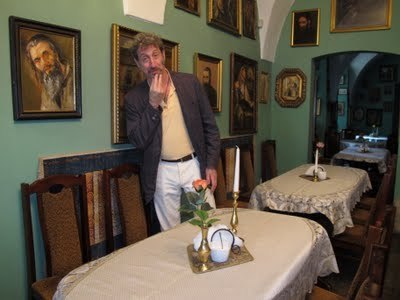 Steve ponders the Ariel. Photo (c) Ruth Ellen Gruber
Steve ponders the Ariel. Photo (c) Ruth Ellen GruberBy Ruth Ellen Gruber
In the Forward's "Jew and the Carrot" blog, I rate six of the most prominent Jewish/"Jewish" cafes in Krakow's Kazimierz district, with help from Steve Weintraub.
Nowadays, visitors are still sometimes shocked by the extent of the kitsch (Szeroka St, the main square in Jewish Kazimierz and the hub of Jewish tourism, souvenir stalls and Jewish-themed venues, is sometimes referred to as "Jewrassic Park".) But the Jewish themed cafes are actually now in the minority — Kazimierz has become a major district of youth-oriented night life and music, with scores of pubs, clubs, cafes and eateries of all sorts.
This year, during the Festival, I enlisted two festival participants — Chicago-based dancer Steve Weintraub and Berlin-based trumpeter Paul Brody — to join me on a couple of "café crawls" to rate half a dozen of the most prominent Jewish themed establishments in the district, from ones that are over the top, to the ones that are a nice place to hang out.
Klezmer Hois
A meeting place for local and visiting Jewish intellectuals and artists, K-H is run by Wojtek and Malgosia Ornat, who also operate a Jewish publishing house and bookstore. Both have Jewish roots. The Ornats' first Jewish themed café, opened in 1992, was the first in Kazimierz, and their take on style, décor and menu have influenced many other cafes in the district and in other cities. Its front room is an intimate café/restaurant, but it also has larger dining rooms. Up flights of creaky stairs is a hotel with old-fashioned furnishings. In the shady garden, you can enjoy one of the best breakfasts in town — home-baked rolls, sour cherry jam, cheeses, fruit, eggs and hummus. Szeroka 6
Once Upon A Time In Kazimierz
The highly theatrical concept has always caused me to cringe a bit. The exterior of the café/restaurant is mocked up to look like a row of pre-war shops, with weathered-looking shop signs fronting the street like Benjamin Holcer's Carpentry Shop and Chajim Cohen's General Store. Big signs explain that the restaurant "takes us down memory lane to that bygone time." The interior resembles an overstocked antique or curio shop crowded with items relating to the false-front shops, but it is surprisingly pleasant, achieving a sort of warm, fuzzy coziness. The menu is small but the duck with cherries comes recommended. Szeroka 1
Noah's Ark (Arka Noego)
Noah's Ark, one of the best known Jewish cafés, opened in 1995 and was long located in a historic building with vaulted ceilings on Szeroka. It recently moved and it may be unfair to judge it yet on its new incarnation — the lace tablecloths and candlesticks are in place, live klezmer bands play at night and the restaurant is full — but everything is still so new that it's rather soulless. Its menu still offers dishes with names like "Cheese Soup of Jealous Sarah" and "Veal in Garlic Sauce for the Klezmers." Corner of Izaaka and Kupa streets
Cheder
This pleasant little café is an offshoot of the Festival of Jewish Culture. It has a low-key atmosphere, a library of Jewish books, and it serves exotic teas and coffees, kosher wine, and Israeli snacks such as pita, cheeses, olives and sun-dried tomatoes. Cheder aims to serve as an informal Jewish cultural center and hosts book presentations, readings, concerts and other events often keyed to contemporary Jewish culture. Jozefa 36
Sara
Sara used to be a forbiddingly stark, modern café in the Jewish Culture Center located in a renovated prayer house at the edge of Plac Nowy. It has undergone redecoration to make it much more cozy, but it still eschews nostalgic kitsch. Its roof garden has a terrific view of Plac Nowy and Kazimierz rooftops, in what may be the most secluded and secret spot in the district. At the center for Jewish culture, Meisels 17
Ariel
Ariel was the first Jewish-style venue to open — back in 1992 when it was run by Wojtek and Malgosia Ornat (now the owners of Klezmer Hois). Today, it is the most blatantly commercial of them all. It is a rambling establishment, catering to groups. Its facade sports a huge menorah flanked by lions and dominates Szeroka. While the outdoor seating is pleasant enough, the dozens of paintings of rabbis and other Jewish imagery that decorate its interior strike me as prime examples off-the-shelf "Jewish." Its little shop selling carved figurines of Jews and even refrigerator magnets of Jewish heads with stereotype profiles makes me particularly uncomfortable. There's a large menu, but the rugelach we ordered were too stale to eat. Szeroka 18
Read more: http://blogs.forward.com/the-jew-and-the-carrot/139814/#ixzz1S6xXB4Ug
Published on July 14, 2011 13:08
July 9, 2011
JHT makes a list of Top 20 Jewish blogs
By Ruth Ellen Gruber
This blog has been included on a list of Top 20 Jewish Blogs by a web site that is a guide to schools offering Theology degrees online. It's a rather eclectic list, with some wellknown and lesser known blogs on a range of topics.

This blog has been included on a list of Top 20 Jewish Blogs by a web site that is a guide to schools offering Theology degrees online. It's a rather eclectic list, with some wellknown and lesser known blogs on a range of topics.
Learning about Judaism can seem daunting, but like many of the other major religions, it has key principles and practices that will help you get a handle on your busy modern lifestyle. If you're converting to Judaism or looking to brush up on your history, these blogs provide resources that allow you to learn at your own pace.
Published on July 09, 2011 14:28
July 2, 2011
Poland again
By Ruth Ellen Gruber
I realize I haven't posted for more than a week - a week so full of experiences that should go on this blog that I feel I'll never catch up!
I'm in Poland, where I have been at the annual Festival of Jewisg Culture, the great mix of performance and party where I try to come every year, and which I have written about so much.
As I type this, I am sitting in the cafe of the Galicia Jewish Museum, waiting for the start of the gala outdoor concert that mark the final Saturday night of the festival. They used to call it the Final Concert, but you can't say that really now, as further events go on on Sunday, Including some concerts. The official name is Shalom on Szeroka (Szeroka is the name of the main Jewish square in Krakow's Jewish district, Kazimierz). But it looks like this year they have gone back to calling it Jewish Woodstock -- which was a term used to describe the festival already in 1992....
I love the signage you see on the square - have not yest downloaded pictures but will post some examples. One sign advertises that the cafe inquestion takes "reservations for Shalom."
The weather is not great, chilly and rain is forecast. I plan to stay for a couple of hours, to meet up with some people, and then I am heading back to Oswiecim, an hiur away, the town outside of which Auschwitz is located, where I have been staying - I'm writing about attempts by the town to redefine itself, something I first wrote about 18 years ago in the chapter "Snowbound in Auschwitz" in my 1994 book Upon the Doorposts of Thy House. A lot has changed, but also not....
I realize I haven't posted for more than a week - a week so full of experiences that should go on this blog that I feel I'll never catch up!
I'm in Poland, where I have been at the annual Festival of Jewisg Culture, the great mix of performance and party where I try to come every year, and which I have written about so much.
As I type this, I am sitting in the cafe of the Galicia Jewish Museum, waiting for the start of the gala outdoor concert that mark the final Saturday night of the festival. They used to call it the Final Concert, but you can't say that really now, as further events go on on Sunday, Including some concerts. The official name is Shalom on Szeroka (Szeroka is the name of the main Jewish square in Krakow's Jewish district, Kazimierz). But it looks like this year they have gone back to calling it Jewish Woodstock -- which was a term used to describe the festival already in 1992....
I love the signage you see on the square - have not yest downloaded pictures but will post some examples. One sign advertises that the cafe inquestion takes "reservations for Shalom."
The weather is not great, chilly and rain is forecast. I plan to stay for a couple of hours, to meet up with some people, and then I am heading back to Oswiecim, an hiur away, the town outside of which Auschwitz is located, where I have been staying - I'm writing about attempts by the town to redefine itself, something I first wrote about 18 years ago in the chapter "Snowbound in Auschwitz" in my 1994 book Upon the Doorposts of Thy House. A lot has changed, but also not....
Published on July 02, 2011 08:49
June 22, 2011
Italy -- Pesaro Jewish heritage route is on again this summer
Pesaro synagogue. From www.pesarocultura.it
By Ruth Ellen Gruber
Once again, visitors to Pesaro (and locals, too, of course) this summer will be able to visit Jewish heritage sites around the city. Though unfortunately they seem to be open only on Thursday afternoons between June 23 and September 1.
Sites include the old Jewish quarter, the synagogue, whose complex includes a mikvah and a matzo oven, and the old Jewish cemetery.
For information on the synagogue, call: +39-0721 387541-474
For the Jewish cemetery: +39-335 1746509
By Ruth Ellen Gruber
Once again, visitors to Pesaro (and locals, too, of course) this summer will be able to visit Jewish heritage sites around the city. Though unfortunately they seem to be open only on Thursday afternoons between June 23 and September 1.
Sites include the old Jewish quarter, the synagogue, whose complex includes a mikvah and a matzo oven, and the old Jewish cemetery.
For information on the synagogue, call: +39-0721 387541-474
For the Jewish cemetery: +39-335 1746509
Published on June 22, 2011 04:22
June 21, 2011
Nice article in the Forward on overlooked Jewish heritage sites
 Wonderful carved stone in Siret. Photo (c) Ruth Ellen Gruber
Wonderful carved stone in Siret. Photo (c) Ruth Ellen GruberBy Ruth Ellen Gruber
Michael Luongo has a nice wrapup in The Forward about the "Top 10 Overlooked Jewish Heritage Sites From Around the Globe." It's called "Forgotten History." And thanks, Mike for mentioning this blog!
When most of us think of Jewish heritage travel, places like Jerusalem or the Warsaw Ghetto come to mind. Yet, from the pre-Inquisition sites that dot Spain, to farming villages in South America, hundreds of forgotten or under-visited Jewish sites exist across the world. When we put out the call for recommendations of our readers' favorite overlooked sites on the Forward's Shmooze blog and Facebook page, we got a global range of answers. Not surprising, most of the suggestions were about Eastern Europe. From your recommendations and my own travels, here's an informal list of the top 10 Jewish sites often overlooked by traveler
Read more: http://forward.com/articles/138890/#ixzz1PvK2lPPF
The sites on the list range from Europe, to Latin America to New Zealand.....
It's always hard for me to choose a favorite or "best" or "most overlooked" site -- but I nominated my beloved Jewish cemeteries and painted synagogues in northern Romania and western Ukraine.
Published on June 21, 2011 08:16
June 20, 2011
Tourism -- An interesting essay on tourism to Jewish sites by Alex Joffe
By Ruth Ellen Gruber
There is an interesting essay in Jewish Ideas Daily about ebbs, flows and other "dilemmas" in Jewish-themed tourism, written by Alex Joffe, who is described as a research scholar with the Institute for Jewish and Community Research. He starts from considering the archeological remains of an ancient synagogue in Albania, excavated as a potential tourist site seven or eight years ago, but now languishing and all but abandoned.
Tourism, he writes, "is not just a recreational and aesthetic experience for the tourist. It is a business, and as such it poses moral questions as to the specific experiences that are bought and sold."
Some of the issues he raises are among those I discussed both in the introduction of Jewish Heritage Travel and in the chapter on Travel in Virtually Jewish: Reinventing Jewish Culture in Europe. Such as the role of actual living Jewish communities in far-flung places, and whether or not visiting Jewish heritage sites entails any particular responsibilities or sensitivities.

There is an interesting essay in Jewish Ideas Daily about ebbs, flows and other "dilemmas" in Jewish-themed tourism, written by Alex Joffe, who is described as a research scholar with the Institute for Jewish and Community Research. He starts from considering the archeological remains of an ancient synagogue in Albania, excavated as a potential tourist site seven or eight years ago, but now languishing and all but abandoned.
Tourism, he writes, "is not just a recreational and aesthetic experience for the tourist. It is a business, and as such it poses moral questions as to the specific experiences that are bought and sold."
Some of the issues he raises are among those I discussed both in the introduction of Jewish Heritage Travel and in the chapter on Travel in Virtually Jewish: Reinventing Jewish Culture in Europe. Such as the role of actual living Jewish communities in far-flung places, and whether or not visiting Jewish heritage sites entails any particular responsibilities or sensitivities.
Even among the dead, the ethical questions are real, and the ironies are evident. While Albanians had hoped to use their commendable historical story to draw tourists, their synagogue now languishes and decays. Meanwhile, Nazi concentration and death camps, above all Auschwitz, are sites of pilgrimage and remembrance—and a source of significant tourism revenues to Germany and Poland.I'm not sure that I find the questions and challenges (if they are really questions and challenges) he brings up mutually exclusive. There is no "should" entailed in where anyone -- Jewish or not -- chooses to visit. Jewish heritage places are interesting and important in themselves -- in different ways. Each one tells a different story, though, of course, some of the stories are related. But it seems besides the point to make it seem an ethical choice -- or to pose it in terms of making it an ethical choice -- as to whether you will visit Auschwitz or the excavated ruins of an ancient synagogue in Albania.
Why go one place rather than another? Albanians saved "their" Jews—are they owed something in return by Jewish tourists? Or should Jews instead visit Germany and Poland, to keep the Jewish histories of those countries from falling victim to the Nazis, to rebuild Jewish life, or even to offer prayers at cemeteries?
The scale of the problem is overwhelming, as there is no end to Jewish heritage sites. Everywhere Jews lived, they left behind schools and synagogues, dwellings, markets and factories, and cemeteries. Few of these sites are beautiful. Proportionally, sand-floor synagogues in Curaçao are vastly outnumbered by destroyed or usurped synagogues in Ukraine or Belarus. And everywhere there are the cemeteries, mass graves, and other assorted killing fields—overgrown and forgotten, ploughed up, or routinely desecrated. Another responsibility thus looms, to preserve the dignity of the Jewish dead.
But the synagogue of Onchesmos deserves to be seen—and not only by Jews. After all, remembering that Jews were a vital part of the Mediterranean world is, if nothing else, important to understanding that they remain a living part of that world today. Archeologists have responsibilities as well, not only to preserve the remains but to present them in such a way that they become at least a small part of the living present. Otherwise they should be left in peace.
Published on June 20, 2011 05:09
Poland -- the Chassidic Route: Sanok
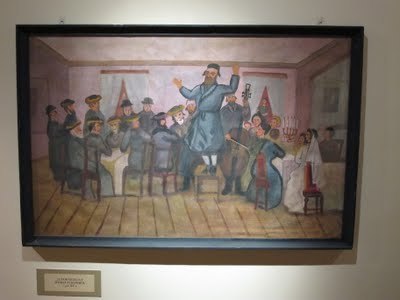 Painting in Judaica exhibit at Open Air Museum.
Painting in Judaica exhibit at Open Air Museum.By Ruth Ellen Gruber
Sanok, in the far southeastern tip of Poland, is a charming little town centered around a castle and nice little main market square -- it is a gateway to the Bieszcszady mountains, a beautiful region of lush hills, rushing streams and all the bucolic beauty that goes with it. I was there to write about the project constructing a replica of the destroyed Gwozdziec wooden synagogue -- and I've already posted on this.
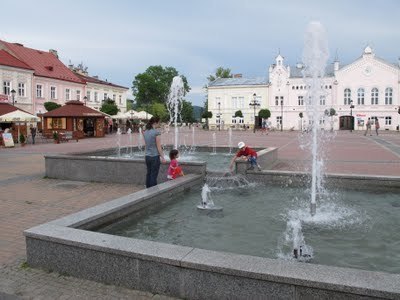 Sanok - main square. Photo (c) Ruth Ellen Gruber
Sanok - main square. Photo (c) Ruth Ellen GruberBut, because of its long, rich Jewish history, Sanok, where Jews settled in the 16th century, is a stop on the Chassidic Route traced by the Foundation for the Preservation of Jewish Heritage in Poland, or FODZ. The town was a center of Chassidism in the 19th century, and before the Holocaust, Jews made up between 40 ad 50 percent of the local population.
There are only a few traces left of this vivid world.
The most interesting is the small but valuable collection of Judaica, photographs, paintings and other material housed at Sanok's open-air folk architecture museum, or skansen, a sprawling display of wonderful wooden village architecture.
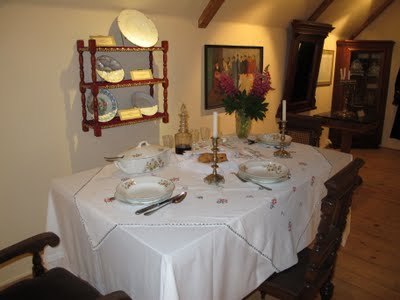
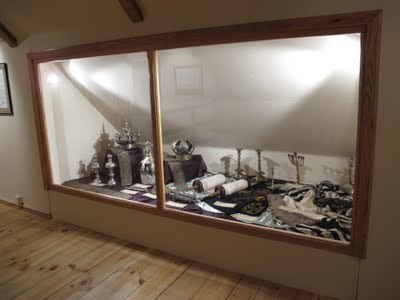 Photos (c) Ruth Ellen Gruber
Photos (c) Ruth Ellen GruberIt's all displayed in a long, bright room in a complex of buildings housing examples of Christian folk art, including carved wooden figures, and centuries-old icons.
Among the skansen buildings are a couple of houses once owned by Jews. But the museum director told me that there were plans to build a replica of one of the destroyed wooden synagogues -- the 18th century synagogue of Polaniec, for which ample documentation survives. The replica, (if and) when built, will form part of a newly built replica of a smalltown market square which is to open this summer.
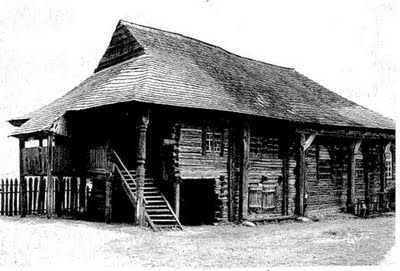 Polaniec wooden synagogue. Picture from virtual shtetl web site
Polaniec wooden synagogue. Picture from virtual shtetl web site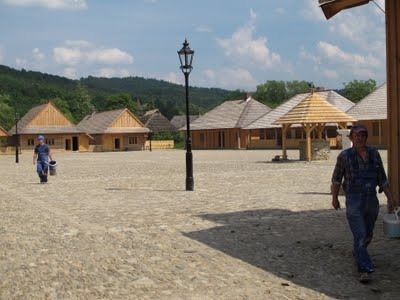 Sanok -- unfinished replica of market square. Photo (c) Ruth Ellen Gruber
Sanok -- unfinished replica of market square. Photo (c) Ruth Ellen GruberIn town, there are a couple of synagogue buildings, rebuilt for other purposes. There is also one surviving Jewish cemetery, dating from the 19th century -- it's next to the Catholic cemetery. Only a few gravestones remain. There is also a Holocaust memorial.
 Jewish cemetery, Sanok. Photo (c) Ruth Ellen Gruber
Jewish cemetery, Sanok. Photo (c) Ruth Ellen Gruber
Published on June 20, 2011 01:20
June 18, 2011
Poland -- the Chassidic Route: Baligrod
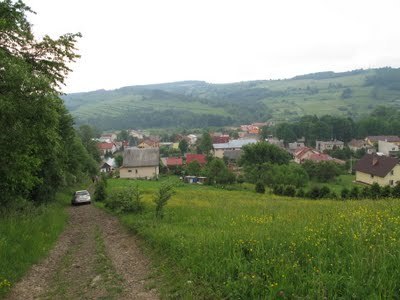 My car is parked at the entrance to the cemetery, pointing back toward the village. It was a bit tricky turning around. Photo (c) Ruth Ellen Gruber
My car is parked at the entrance to the cemetery, pointing back toward the village. It was a bit tricky turning around. Photo (c) Ruth Ellen GruberBy Ruth Ellen Gruber
The village of Baligrod, about 20 km south of Lesko, is another stop on the Chassidic Route itinerary sponsored by the Foundation for the Preservation of Jewish Heritage in Poland (FODZ).
Jews lived here from the early 17th century and for much of the period between the 18th century and World War II they made up a majority of the residents. The synagogue and other buildings were destroyed in WWII.
The Jewish cemetery survives on a hill overlooking the town — a lovely spot with a beautiful view -- and the narrow, bumpy dirt road is clearly marked by signposts from the village. I drove up (as I didn't know how far it would be) but it would make more sense to park below and walk.
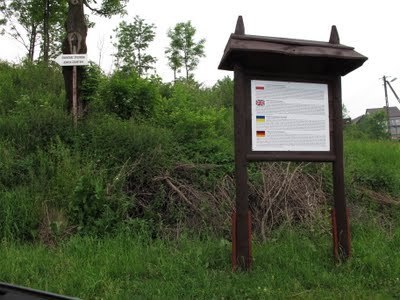 Photo: Ruth Ellen Gruber
Photo: Ruth Ellen GruberThere are supposed to be about 200 stones here; the oldest legible date from 1718 and 1732. The Nazis used hundreds of gravestones to pave the market square -- they are believed still to be there, covered by asphalt.
The cemetery was restored in 2008, and the stones are in good condition — and there is even an incongruous red trash can for visitors to deposite rubbish (it was filled with used plastic water bottles) – but when I visited the grass and weeds were chest-high , in sore need of cutting. The grass totally obscured some of the stones -- I tried to see as many as I could, but I know I didn't see them all.
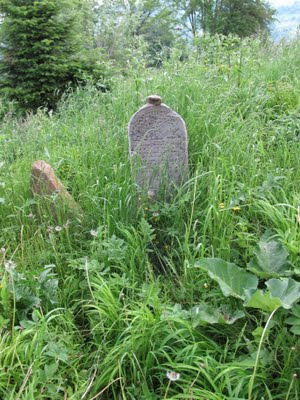 Photo (c) Ruth Ellen Gruber
Photo (c) Ruth Ellen GruberStill, I found many beautifully carved stones, with a variety of candlestick shapes on women's stones, ranging from crude but delicate incised images to more elaborate styles, some featuring candlesticks flanked by birds. See more candlesticks stones at my candlesticksonstone.wordpress.com site.
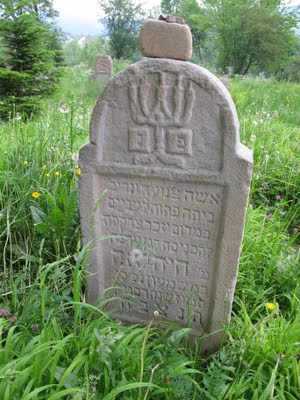 Photo (c) Ruth Ellen Gruber
Photo (c) Ruth Ellen GruberSomeone had clearly visited a short while before I did, though, as there were narrow paths tromped through the grass, and someone had piled stones and pebbles on many of the gravestones.
 Photo (c) Ruth Ellen Gruber
Photo (c) Ruth Ellen Gruber
Published on June 18, 2011 03:34



